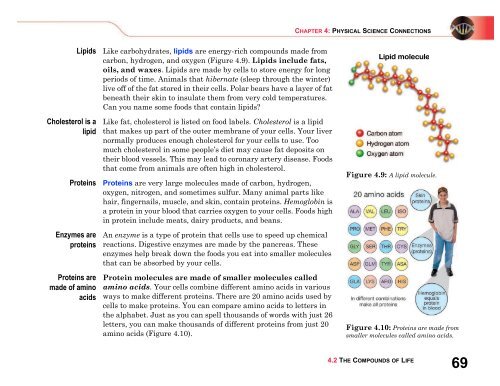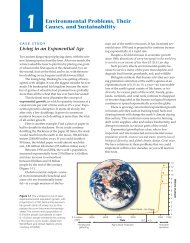Chapters 4 - Spokane Public Schools
Chapters 4 - Spokane Public Schools
Chapters 4 - Spokane Public Schools
You also want an ePaper? Increase the reach of your titles
YUMPU automatically turns print PDFs into web optimized ePapers that Google loves.
CHAPTER 4: PHYSICAL SCIENCE CONNECTIONS<br />
Lipids<br />
Cholesterol is a<br />
lipid<br />
Proteins<br />
Enzymes are<br />
proteins<br />
Proteins are<br />
made of amino<br />
acids<br />
Like carbohydrates, lipids are energy-rich compounds made from<br />
carbon, hydrogen, and oxygen (Figure 4.9). Lipids include fats,<br />
oils, and waxes. Lipids are made by cells to store energy for long<br />
periods of time. Animals that hibernate (sleep through the winter)<br />
live off of the fat stored in their cells. Polar bears have a layer of fat<br />
beneath their skin to insulate them from very cold temperatures.<br />
Can you name some foods that contain lipids<br />
Like fat, cholesterol is listed on food labels. Cholesterol is a lipid<br />
that makes up part of the outer membrane of your cells. Your liver<br />
normally produces enough cholesterol for your cells to use. Too<br />
much cholesterol in some people’s diet may cause fat deposits on<br />
their blood vessels. This may lead to coronary artery disease. Foods<br />
that come from animals are often high in cholesterol.<br />
Proteins are very large molecules made of carbon, hydrogen,<br />
oxygen, nitrogen, and sometimes sulfur. Many animal parts like<br />
hair, fingernails, muscle, and skin, contain proteins. Hemoglobin is<br />
a protein in your blood that carries oxygen to your cells. Foods high<br />
in protein include meats, dairy products, and beans.<br />
An enzyme is a type of protein that cells use to speed up chemical<br />
reactions. Digestive enzymes are made by the pancreas. These<br />
enzymes help break down the foods you eat into smaller molecules<br />
that can be absorbed by your cells.<br />
Protein molecules are made of smaller molecules called<br />
amino acids. Your cells combine different amino acids in various<br />
ways to make different proteins. There are 20 amino acids used by<br />
cells to make proteins. You can compare amino acids to letters in<br />
the alphabet. Just as you can spell thousands of words with just 26<br />
letters, you can make thousands of different proteins from just 20<br />
amino acids (Figure 4.10).<br />
Figure 4.9: A lipid molecule.<br />
Figure 4.10: Proteins are made from<br />
smaller molecules called amino acids.<br />
4.2 THE COMPOUNDS OF LIFE<br />
69

















